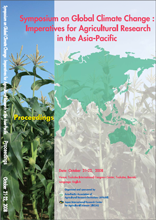Adaptation Opportunities to Global Climate Change in Agriculture in Asia-Pacific

Agricultures in not a few Asian countries are facing difficult situation for sustaining future food
security and livelihood under increasing population and scarce resources. Global climate change
associated with continued greenhouse gas emissions is predicted to give enormous influences on
agriculture within this century through changes in potential crop growth period, positive and negative
effects of increased temperature on crop and livestock production, increased frequency and severity of
droughts and floods, and increased pests, diseases and soil degradations (IPCC, 2007). Global climate
change is likely to further exacerbate food security and livelihood in Asia, unless effective adaptation
to it.
There are many measures for agricultures to adapt to global climate change: altered genotypes
and cropping seasons, adaptive resource management, altered crop species and cropping systems,
creation of innovative genotypes and technologies, infrastructural development, social correspondence,
and their integration. Adoption of altered genotypes and cropping seasons is the most basic measure
for reducing risks of crop damages or failures due to increased abiotic and biotic stresses under global
warming climates. This adaptation requires genotypes to safely complete their life cycles under given
climatic conditions, to have high resistances to abiotic and biotic stresses and, hence, to perform high
yields. Especially, crop resistance to environmental stresses at reproductive development stage is
important for successful adaptation, because a short-term stress in this stage often give crucial effect
on the yield. A simulation study on rice suggested that adoption of genotypes with lower sensitivity to
flowering-time heat stress only by 1-2 oC than the current cultivars and adaptive cropping seasons
drastically improved negative effects of global warming on the yield (Horie et al., 1996).
Resource management is another measure for agricultural adaptation to global climate change.
This includes water and nutrient management technologies for their efficient use, such as mulching,
field incorporations of clay-rich soils and organic materials, micro and drip trickle irrigations, and
application of controlled-release fertilizers of which release pattern highly match given temperature
conditions. Also, integrated pest management is expected to play important roles in reducing increased
biotic stresses to crops and animals under global warming.
When negative effects of global climate change exceed the adaptation capacities of the above
mentioned measures, adoption of altered crop species and cropping systems may be required. This
includes replacement of C3 crops with C4 species, change from double rice cropping systems to
upland-lowland rotation systems to save water and reduce insect and disease damages, and so on.
Creation of innovative genotypes with much higher resistances to biotic and abiotic stresses is
undoubtedly important measure for agricultural adaptation to global climate change. This requires
plant breeding by marker-assisted methods and gene transformation technologies as well as by
traditional breeding methods. Another measure for agricultural adaptation is the development of
infrastructures such as water reservoirs, irrigation and drainage channels for water control, tidal-wave
protection dikes and terrace channels for soil erosion protection. Further, social correspondence is
indispensable component for the adaptation. This includes consensus and policies for better use of
water and other resources, education and capacity building of farmers, increased accessibility to
information and technologies, and policies for food stocks and trade for food security.
There are many opportunities for agricultural adaptation to global climate change through the
above mentioned measures and their integration. Technology development for most of these measures
is being tackled in diverse areas of agricultural sciences by national and international organizations.
The important is the acceleration of the technology development, for many symptoms of global
climate change is being observed worldwide (IPCC, 2007). The technology specifically needed for
agricultural adaptation is information technologies for monitor and prediction of climate effects on agro-ecosystems; agricultural hazard maps; early warning to biotic and abiotic stresses; and for
decision support for adaptive management
| 刊行年月日 | |
|---|---|
| 作成者 | Takeshi Horie |
| 著者キーワード |
Global climate change agriculture adaptation environmental stress Asia |
| 公開者 | Japan International Research Center for Agricultural Sciences |
| オンライン掲載日 | |
| 号 | 2008 |
| 開始ページ | 33 |
| 終了ページ | 41 |
| 権利 | Japan International Research Center for Agricultural Sciences |
| 言語 | eng |
